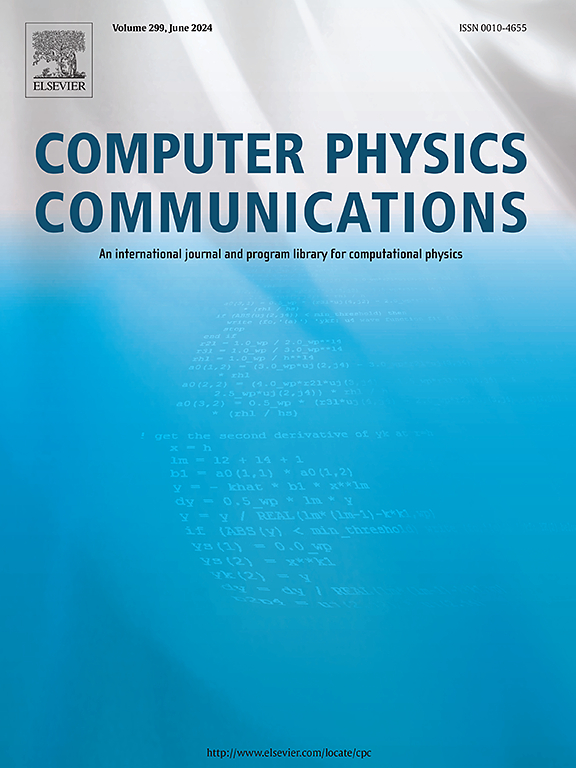高维函数代理建模的自适应学习策略--应用于化学非平衡态下的非稳态高超声速流动
IF 7.2
2区 物理与天体物理
Q1 COMPUTER SCIENCE, INTERDISCIPLINARY APPLICATIONS
引用次数: 0
摘要
许多工程应用依赖于对昂贵的非线性高维函数进行评估。在本文中,我们提出了 RONAALP 算法(Reduced Order Nonlinear Approximation with Adaptive Learning Procedure,自适应学习程序的降阶非线性逼近算法),随着应用的进展,逐步学习目标函数的快速、准确的降阶代理模型。首先,结合非线性自动编码器、群集聚类和径向基函数网络,我们可以利用有限的训练数据学习高效、紧凑的代用模型。其次,主动学习程序克服了在线阶段的任何外推问题,通过对当前有效范围之外的高保真评估来调整代理模型。通过这种方法,可以建立可通用、快速、准确的高维函数降阶模型。该方法在化学非平衡态高超音速流动的三次直接数值模拟中得到了验证。对这些流动的精确模拟依赖于详细的热化学气体模型,这大大增加了计算成本。使用 RONAALP 实时学习减阶热力学代用模型,此类模拟的成本最多可降低 75%,而相关相关量的误差却保持在 10%以下。本文章由计算机程序翻译,如有差异,请以英文原文为准。
An adaptive learning strategy for surrogate modeling of high-dimensional functions - Application to unsteady hypersonic flows in chemical nonequilibrium
Many engineering applications rely on the evaluation of expensive, non-linear high-dimensional functions. In this paper, we propose the RONAALP algorithm (Reduced Order Nonlinear Approximation with Adaptive Learning Procedure) to incrementally learn, on-the-fly as the application progresses, a fast and accurate reduced-order surrogate model of a target function. First, a combination of nonlinear auto-encoder, community clustering, and radial basis function networks allows us to learn an efficient and compact surrogate model with limited training data. Secondly, an active learning procedure overcomes any extrapolation issues during the online stage by adapting the surrogate model with high-fidelity evaluations that fall outside its current validity range. This approach results in generalizable, fast, and accurate reduced-order models of high-dimensional functions. The method is demonstrated on three direct numerical simulations of hypersonic flows in chemical nonequilibrium. Accurate simulations of these flows rely on detailed thermochemical gas models that dramatically increase the cost of such calculations. Using RONAALP to learn a reduced-order thermodynamic model surrogate on-the-fly, the cost of such simulations was reduced by up to 75% while maintaining an error of less than 10% on relevant quantities of interest.
求助全文
通过发布文献求助,成功后即可免费获取论文全文。
去求助
来源期刊

Computer Physics Communications
物理-计算机:跨学科应用
CiteScore
12.10
自引率
3.20%
发文量
287
审稿时长
5.3 months
期刊介绍:
The focus of CPC is on contemporary computational methods and techniques and their implementation, the effectiveness of which will normally be evidenced by the author(s) within the context of a substantive problem in physics. Within this setting CPC publishes two types of paper.
Computer Programs in Physics (CPiP)
These papers describe significant computer programs to be archived in the CPC Program Library which is held in the Mendeley Data repository. The submitted software must be covered by an approved open source licence. Papers and associated computer programs that address a problem of contemporary interest in physics that cannot be solved by current software are particularly encouraged.
Computational Physics Papers (CP)
These are research papers in, but are not limited to, the following themes across computational physics and related disciplines.
mathematical and numerical methods and algorithms;
computational models including those associated with the design, control and analysis of experiments; and
algebraic computation.
Each will normally include software implementation and performance details. The software implementation should, ideally, be available via GitHub, Zenodo or an institutional repository.In addition, research papers on the impact of advanced computer architecture and special purpose computers on computing in the physical sciences and software topics related to, and of importance in, the physical sciences may be considered.
 求助内容:
求助内容: 应助结果提醒方式:
应助结果提醒方式:


